2012 NISSAN 370Z COUPE low oil pressure
[x] Cancel search: low oil pressurePage 22 of 427

0-14Illustrated table of contents
Warninglight Name
Page
Anti-lock Braking System
(ABS) warning light 2-10
Automatic Transmission (AT)
check warning light2-10
Brake warning light
2-10
Charge warning light2-11
Engine oil pressure warning
light 2-11
Intelligent Key system warning
light2-11
Low tire pressure warning light 2-12
Master warning light
2-13
Seat belt warning light 2-13
Supplemental air bag warning
light 2-13
Vehicle Dynamic Control (VDC)
warning light2-14Indicator
light Name Page
Cruise indicator light
2-14
Front passenger air bag status
light 2-14
High beam indicator light 2-14
Low beam indicator lights 2-14
Malfunction Indicator Light
(MIL)2-14
Rear fog light indicator light* 2-15
Security indicator light
2-15
Soft top indicator light (Road-
ster models) 2-15
SynchroRev Match mode (S-
MODE) indicator*2-16
Transmission position indicator
light*2-16
Turn signal/hazard indicator
lights
2-16
Vehicle Dynamic Control (VDC)
off indicator light2-16
*: if so equipped
WARNING AND INDICATOR LIGHTS
Page 73 of 427

Anti-lock Braking System (ABS) warning
lightMaster warning lightRear fog light indicator light*
Seat belt warning light and chimeSecurity indicator light
Automatic transmission check warning light*Supplemental air bag warning lightSoft top indicator light (Roadster models)
Brake warning light
Vehicle Dynamic Control (VDC) warning
lightSynchroRev Match mode (S-MODE) indi-
cator*
Cruise indicator lightTransmission position indicator*
Charge warning lightFront passenger air bag status lightTurn signal/hazard indicator lights
Engine oil pressure warning lightHigh beam indicator lightVehicle Dynamic Control (VDC) off indicator
light
Intelligent Key system warning lightLow beam indicator light*: if so equipped
Low tire pressure warning lightMalfunction Indicator Light (MIL)
Instruments and controls2-9
WARNING/INDICATOR LIGHTS AND
AUDIBLE REMINDERS
Page 75 of 427

paired, by a NISSAN dealer promptly. (See
“Anti-lock Braking System (ABS) warning light”
(P.2-10) .)
WARNING
.Your brake system may not be
working properly if the warning light
is on. Driving could be dangerous. If
you judge it to be safe, drive care-
fully to the nearest service station
for repairs. Otherwise, have your
vehicle towed because driving it
could be dangerous.
. Pressing the brake pedal with the
engine stopped and/or low brake
fluid level may increase your stop-
ping distance and braking will re-
quire greater pedal effort as well as
pedal travel.
. If the brake fluid level is below the
minimum or MIN mark on the brake
fluid reservoir, do not drive until the
brake system has been checked at a
NISSAN dealer.
Charge warning light
If the light comes on while the engine is running,
it may indicate the charging system is not
functioning properly. Turn the engine off and
check the alternator belt. If the belt is loose,
broken, missing or if the light remains on, see a
NISSAN dealer immediately.
CAUTION
Do not continue driving if the alternator
belt is loose, broken or missing.
Engine oil pressure warning light
This light warns of low engine oil pressure. If the
light flickers or comes on during normal driving,
pull off the road in a safe area, stop the engine
immediately and call a NISSAN dealer or other
authorized repair shop.
The engine oil pressure warning light is
not designed to indicate a low oil level.
Use the dipstick to check the oil level. (See
“Engine oil” (P.8-11) .)
CAUTION
Running the engine with the engine oil
pressure warning light on could cause
serious damage to the engine almost
immediately. Such damage is not cov-
ered by warranty. Turn off the engine as
soon as it is safe to do so.
Intelligent Key system warning light
After the ignition switch is pushed to the ON
position, this light comes on for about 2 seconds
and then turns off.
This light warns of a malfunction with the
Intelligent Key system.
If the light comes on while the engine is
stopped, it may be impossible to start the
engine. If the light comes on while the engine
is running, you can drive the vehicle. However in
these cases, contact a NISSAN dealer for repair
as soon as possible.
Instruments and controls2-11
Page 325 of 427
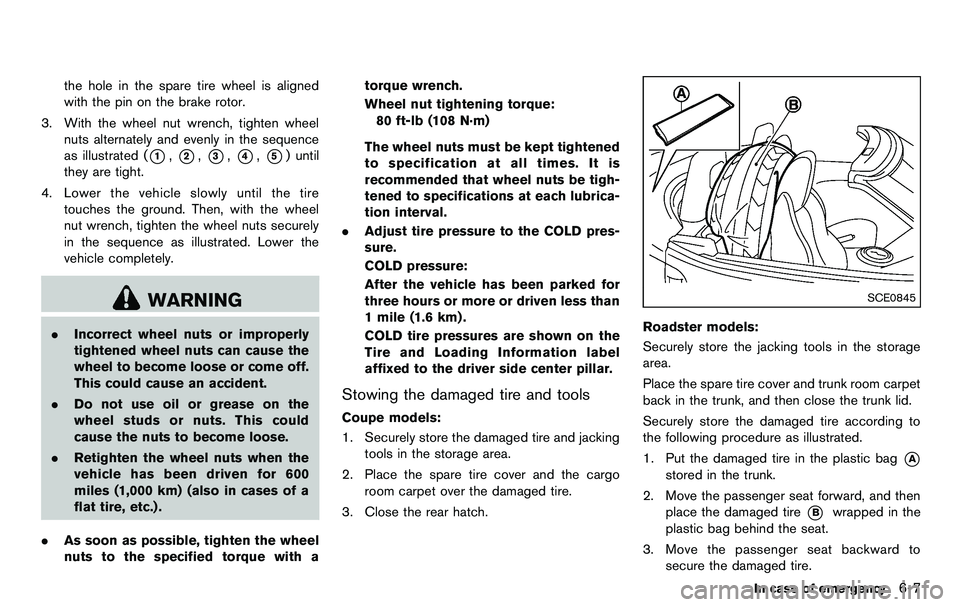
the hole in the spare tire wheel is aligned
with the pin on the brake rotor.
3. With the wheel nut wrench, tighten wheel nuts alternately and evenly in the sequence
as illustrated (
*1,*2,*3,*4,*5) until
they are tight.
4. Lower the vehicle slowly until the tire touches the ground. Then, with the wheel
nut wrench, tighten the wheel nuts securely
in the sequence as illustrated. Lower the
vehicle completely.
WARNING
.Incorrect wheel nuts or improperly
tightened wheel nuts can cause the
wheel to become loose or come off.
This could cause an accident.
. Do not use oil or grease on the
wheel studs or nuts. This could
cause the nuts to become loose.
. Retighten the wheel nuts when the
vehicle has been driven for 600
miles (1,000 km) (also in cases of a
flat tire, etc.) .
. As soon as possible, tighten the wheel
nuts to the specified torque with a torque wrench.
Wheel nut tightening torque:
80 ft-lb (108 N·m)
The wheel nuts must be kept tightened
to specification at all times. It is
recommended that wheel nuts be tigh-
tened to specifications at each lubrica-
tion interval.
. Adjust tire pressure to the COLD pres-
sure.
COLD pressure:
After the vehicle has been parked for
three hours or more or driven less than
1 mile (1.6 km) .
COLD tire pressures are shown on the
Tire and Loading Information label
affixed to the driver side center pillar.
Stowing the damaged tire and tools
Coupe models:
1. Securely store the damaged tire and jacking
tools in the storage area.
2. Place the spare tire cover and the cargo room carpet over the damaged tire.
3. Close the rear hatch.
SCE0845
Roadster models:
Securely store the jacking tools in the storage
area.
Place the spare tire cover and trunk room carpet
back in the trunk, and then close the trunk lid.
Securely store the damaged tire according to
the following procedure as illustrated.
1. Put the damaged tire in the plastic bag
*A
stored in the trunk.
2. Move the passenger seat forward, and then place the damaged tire
*Bwrapped in the
plastic bag behind the seat.
3. Move the passenger seat backward to secure the damaged tire.
In case of emergency6-7
Page 346 of 427
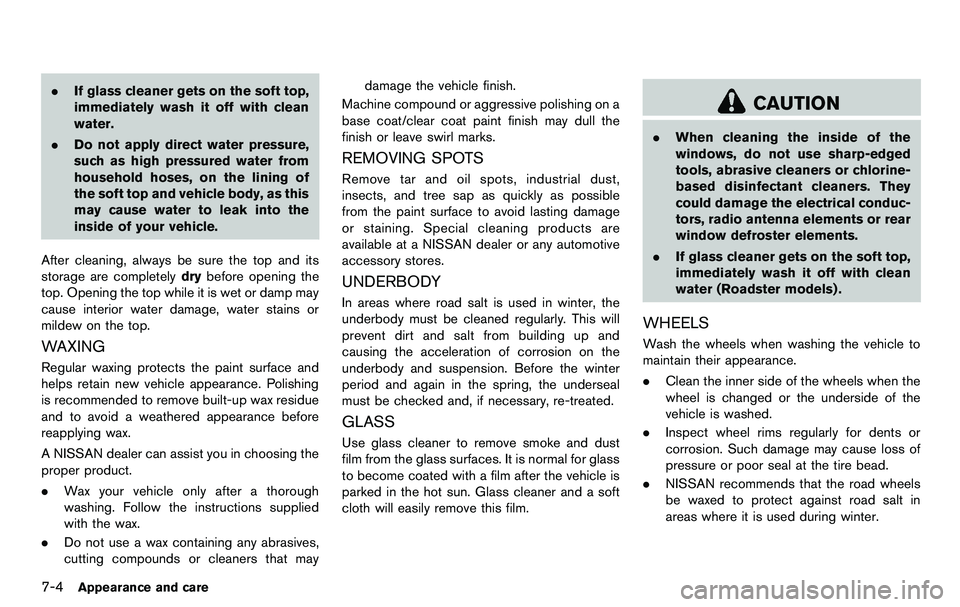
7-4Appearance and care
.If glass cleaner gets on the soft top,
immediately wash it off with clean
water.
. Do not apply direct water pressure,
such as high pressured water from
household hoses, on the lining of
the soft top and vehicle body, as this
may cause water to leak into the
inside of your vehicle.
After cleaning, always be sure the top and its
storage are completely drybefore opening the
top. Opening the top while it is wet or damp may
cause interior water damage, water stains or
mildew on the top.
WAXING
Regular waxing protects the paint surface and
helps retain new vehicle appearance. Polishing
is recommended to remove built-up wax residue
and to avoid a weathered appearance before
reapplying wax.
A NISSAN dealer can assist you in choosing the
proper product.
. Wax your vehicle only after a thorough
washing. Follow the instructions supplied
with the wax.
. Do not use a wax containing any abrasives,
cutting compounds or cleaners that may damage the vehicle finish.
Machine compound or aggressive polishing on a
base coat/clear coat paint finish may dull the
finish or leave swirl marks.
REMOVING SPOTS
Remove tar and oil spots, industrial dust,
insects, and tree sap as quickly as possible
from the paint surface to avoid lasting damage
or staining. Special cleaning products are
available at a NISSAN dealer or any automotive
accessory stores.
UNDERBODY
In areas where road salt is used in winter, the
underbody must be cleaned regularly. This will
prevent dirt and salt from building up and
causing the acceleration of corrosion on the
underbody and suspension. Before the winter
period and again in the spring, the underseal
must be checked and, if necessary, re-treated.
GLASS
Use glass cleaner to remove smoke and dust
film from the glass surfaces. It is normal for glass
to become coated with a film after the vehicle is
parked in the hot sun. Glass cleaner and a soft
cloth will easily remove this film.
CAUTION
. When cleaning the inside of the
windows, do not use sharp-edged
tools, abrasive cleaners or chlorine-
based disinfectant cleaners. They
could damage the electrical conduc-
tors, radio antenna elements or rear
window defroster elements.
. If glass cleaner gets on the soft top,
immediately wash it off with clean
water (Roadster models) .
WHEELS
Wash the wheels when washing the vehicle to
maintain their appearance.
.Clean the inner side of the wheels when the
wheel is changed or the underside of the
vehicle is washed.
. Inspect wheel rims regularly for dents or
corrosion. Such damage may cause loss of
pressure or poor seal at the tire bead.
. NISSAN recommends that the road wheels
be waxed to protect against road salt in
areas where it is used during winter.
Page 358 of 427
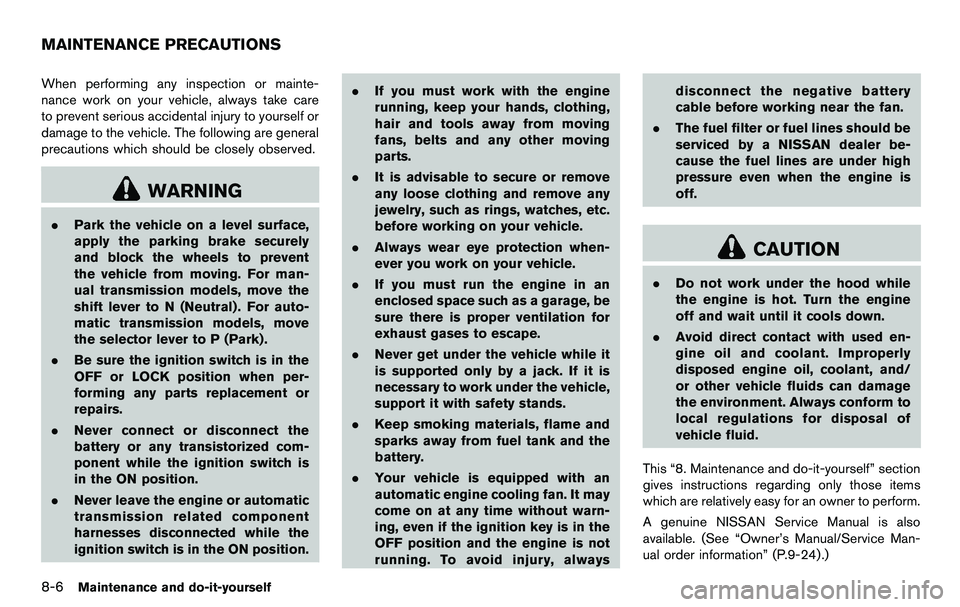
8-6Maintenance and do-it-yourself
When performing any inspection or mainte-
nance work on your vehicle, always take care
to prevent serious accidental injury to yourself or
damage to the vehicle. The following are general
precautions which should be closely observed.
WARNING
.Park the vehicle on a level surface,
apply the parking brake securely
and block the wheels to prevent
the vehicle from moving. For man-
ual transmission models, move the
shift lever to N (Neutral) . For auto-
matic transmission models, move
the selector lever to P (Park) .
. Be sure the ignition switch is in the
OFF or LOCK position when per-
forming any parts replacement or
repairs.
. Never connect or disconnect the
battery or any transistorized com-
ponent while the ignition switch is
in the ON position.
. Never leave the engine or automatic
transmission related component
harnesses disconnected while the
ignition switch is in the ON position. .
If you must work with the engine
running, keep your hands, clothing,
hair and tools away from moving
fans, belts and any other moving
parts.
. It is advisable to secure or remove
any loose clothing and remove any
jewelry, such as rings, watches, etc.
before working on your vehicle.
. Always wear eye protection when-
ever you work on your vehicle.
. If you must run the engine in an
enclosed space such as a garage, be
sure there is proper ventilation for
exhaust gases to escape.
. Never get under the vehicle while it
is supported only by a jack. If it is
necessary to work under the vehicle,
support it with safety stands.
. Keep smoking materials, flame and
sparks away from fuel tank and the
battery.
. Your vehicle is equipped with an
automatic engine cooling fan. It may
come on at any time without warn-
ing, even if the ignition key is in the
OFF position and the engine is not
running. To avoid injury, always disconnect the negative battery
cable before working near the fan.
. The fuel filter or fuel lines should be
serviced by a NISSAN dealer be-
cause the fuel lines are under high
pressure even when the engine is
off.
CAUTION
.Do not work under the hood while
the engine is hot. Turn the engine
off and wait until it cools down.
. Avoid direct contact with used en-
gine oil and coolant. Improperly
disposed engine oil, coolant, and/
or other vehicle fluids can damage
the environment. Always conform to
local regulations for disposal of
vehicle fluid.
This “8. Maintenance and do-it-yourself” section
gives instructions regarding only those items
which are relatively easy for an owner to perform.
A genuine NISSAN Service Manual is also
available. (See “Owner’s Manual/Service Man-
ual order information” (P.9-24).)
MAINTENANCE PRECAUTIONS
Page 422 of 427
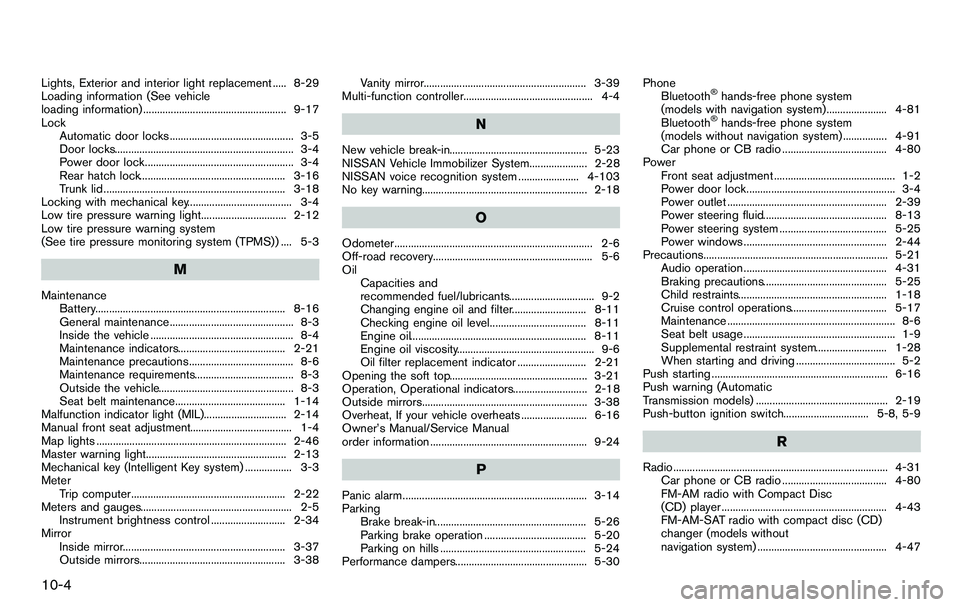
10-4
Lights, Exterior and interior light replacement ..... 8-29
Loading information (See vehicle
loading information) .................................................... 9-17
LockAutomatic door locks ............................................. 3-5
Door locks................................................................. 3-4
Power door lock...................................................... 3-4
Rear hatch lock..................................................... 3-16
Trunk lid .................................................................. 3-18
Locking with mechanical key...................................... 3-4
Low tire pressure warning light............................... 2-12
Low tire pressure warning system
(See tire pressure monitoring system (TPMS)) .... 5-3
M
Maintenance Battery..................................................................... 8-16
General maintenance ............................................. 8-3
Inside the vehicle .................................................... 8-4
Maintenance indicators....................................... 2-21
Maintenance precautions...................................... 8-6
Maintenance requirements.................................... 8-3
Outside the vehicle................................................. 8-3
Seat belt maintenance........................................ 1-14
Malfunction indicator light (MIL).............................. 2-14
Manual front seat adjustment..................................... 1-4
Map lights ..................................................................... 2-46
Master warning light................................................... 2-13
Mechanical key (Intelligent Key system) ................. 3-3
Meter Trip computer........................................................ 2-22
Meters and gauges....................................................... 2-5 Instrument brightness control ........................... 2-34
Mirror Inside mirror........................................................... 3-37
Outside mirrors..................................................... 3-38 Vanity mirror........................................................... 3-39
Multi-function controller............................................... 4-4
N
New vehicle break-in.................................................. 5-23
NISSAN Vehicle Immobilizer System..................... 2-28
NISSAN voice recognition system ...................... 4-103
No key warning............................................................ 2-18
O
Odometer........................................................................ 2-6
Off-road recovery.......................................................... 5-6
Oil Capacities and
recommended fuel/lubricants............................... 9-2
Changing engine oil and filter........................... 8-11
Checking engine oil level................................... 8-11
Engine oil................................................................ 8-11
Engine oil viscosity.................................................. 9-6
Oil filter replacement indicator ......................... 2-21
Opening the soft top.................................................. 3-21
Operation, Operational indicators........................... 2-18
Outside mirrors............................................................ 3-38
Overheat, If your vehicle overheats ........................ 6-16
Owner’s Manual/Service Manual
order information ......................................................... 9-24
P
Panic alarm................................................................... 3-14
Parking Brake break-in....................................................... 5-26
Parking brake operation ..................................... 5-20
Parking on hills ..................................................... 5-24
Performance dampers................................................ 5-30 Phone
Bluetooth
®hands-free phone system
(models with navigation system)...................... 4-81
Bluetooth
®hands-free phone system
(models without navigation system) ................ 4-91
Car phone or CB radio ...................................... 4-80
Power Front seat adjustment ............................................ 1-2
Power door lock...................................................... 3-4
Power outlet .......................................................... 2-39
Power steering fluid............................................. 8-13
Power steering system ....................................... 5-25
Power windows .................................................... 2-44
Precautions................................................................... 5-21 Audio operation .................................................... 4-31
Braking precautions............................................. 5-25
Child restraints...................................................... 1-18
Cruise control operations................................... 5-17
Maintenance ............................................................. 8-6
Seat belt usage ....................................................... 1-9
Supplemental restraint system.......................... 1-28
When starting and driving .................................... 5-2
Push starting ................................................................ 6-16
Push warning (Automatic
Transmission models) ................................................ 2-19
Push-button ignition switch............................... 5-8, 5-9
R
Radio.............................................................................. 4-31 Car phone or CB radio ...................................... 4-80
FM-AM radio with Compact Disc
(CD) player ............................................................ 4-43
FM-AM-SAT radio with compact disc (CD)
changer (models without
navigation system) ............................................... 4-47
Page 426 of 427
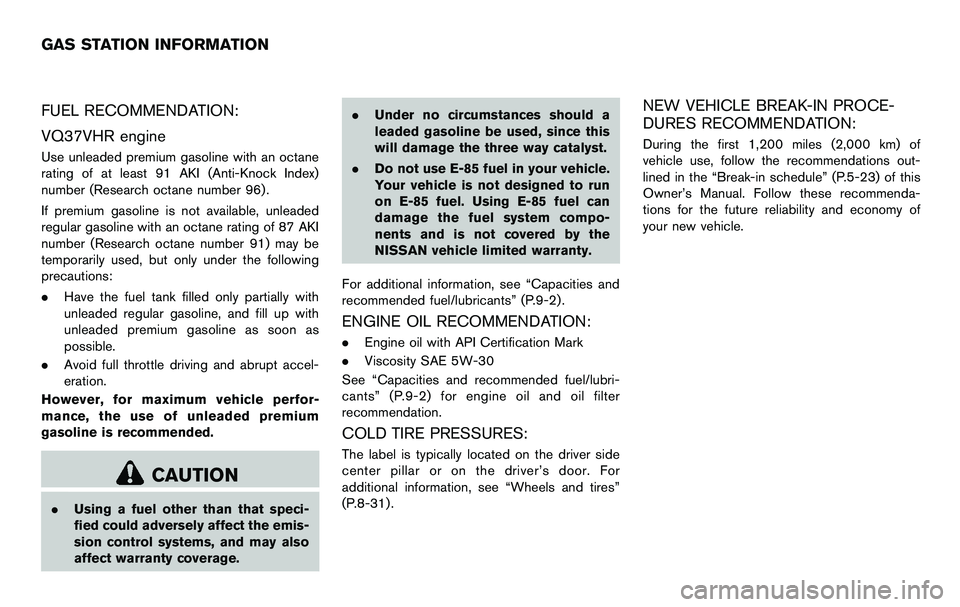
FUEL RECOMMENDATION:
VQ37VHR engine
Use unleaded premium gasoline with an octane
rating of at least 91 AKI (Anti-Knock Index)
number (Research octane number 96).
If premium gasoline is not available, unleaded
regular gasoline with an octane rating of 87 AKI
number (Research octane number 91) may be
temporarily used, but only under the following
precautions:
.Have the fuel tank filled only partially with
unleaded regular gasoline, and fill up with
unleaded premium gasoline as soon as
possible.
. Avoid full throttle driving and abrupt accel-
eration.
However, for maximum vehicle perfor-
mance, the use of unleaded premium
gasoline is recommended.
CAUTION
. Using a fuel other than that speci-
fied could adversely affect the emis-
sion control systems, and may also
affect warranty coverage. .
Under no circumstances should a
leaded gasoline be used, since this
will damage the three way catalyst.
. Do not use E-85 fuel in your vehicle.
Your vehicle is not designed to run
on E-85 fuel. Using E-85 fuel can
damage the fuel system compo-
nents and is not covered by the
NISSAN vehicle limited warranty.
For additional information, see “Capacities and
recommended fuel/lubricants” (P.9-2) .
ENGINE OIL RECOMMENDATION:
. Engine oil with API Certification Mark
. Viscosity SAE 5W-30
See “Capacities and recommended fuel/lubri-
cants” (P.9-2) for engine oil and oil filter
recommendation.
COLD TIRE PRESSURES:
The label is typically located on the driver side
center pillar or on the driver’s door. For
additional information, see “Wheels and tires”
(P.8-31) .
NEW VEHICLE BREAK-IN PROCE-
DURES RECOMMENDATION:
During the first 1,200 miles (2,000 km) of
vehicle use, follow the recommendations out-
lined in the “Break-in schedule” (P.5-23) of this
Owner’s Manual. Follow these recommenda-
tions for the future reliability and economy of
your new vehicle.
GAS STATION INFORMATION